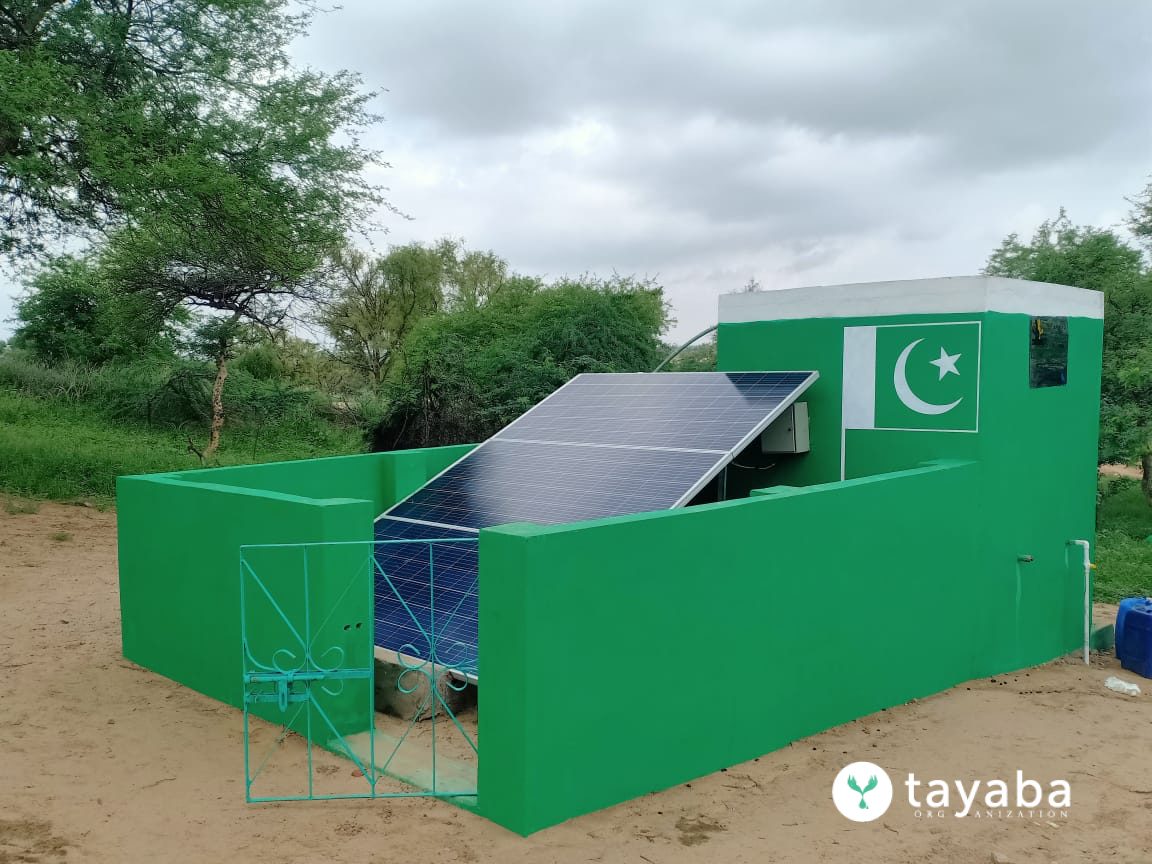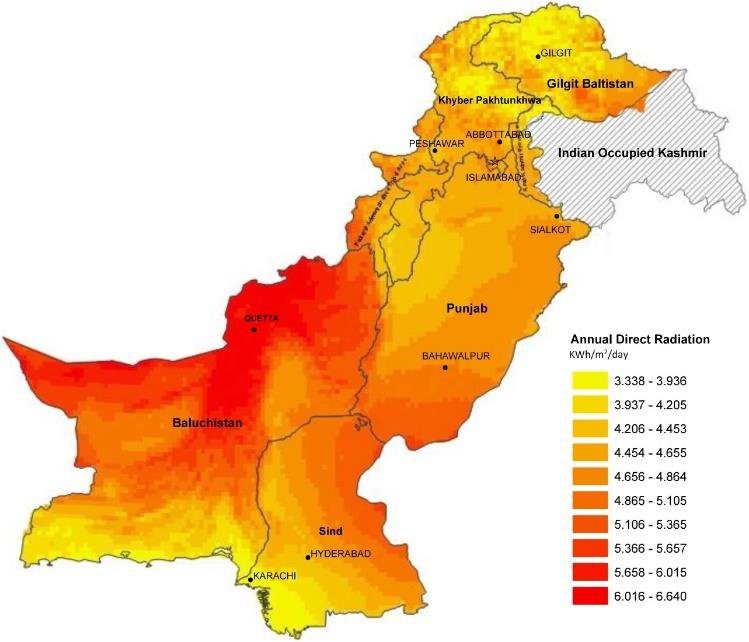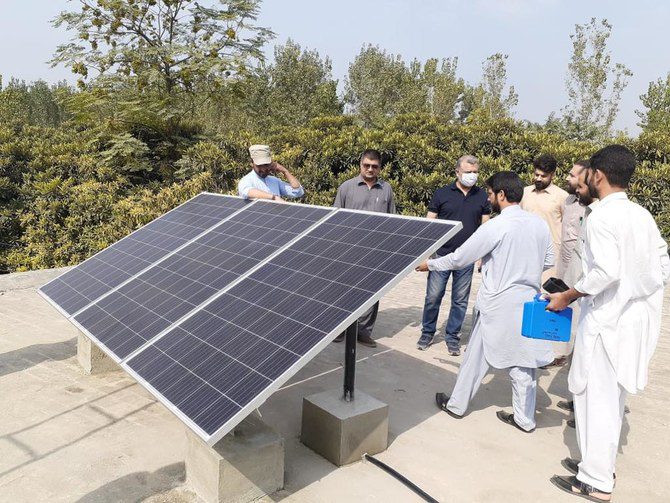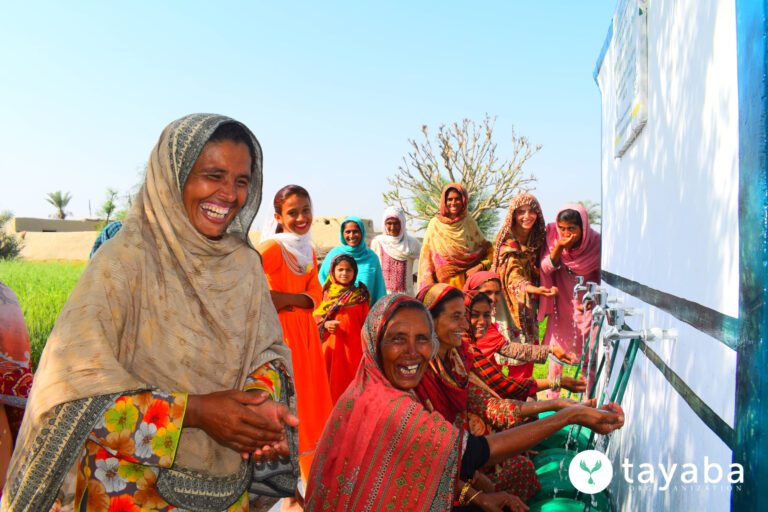Blogs and Articles
Harnessing Solar Energy for Sustainable Water Solutions:
The Case of Pakistan

Photo by Tayaba Organisation – All Rights Reserved
Introduction:
Pakistan, a country facing the dual challenges of power generation and water scarcity, is turning to solar energy as a sustainable solution. With favorable government policies, increased foreign investment, and technological advancements, Pakistan has the opportunity to revolutionize its power generation sector and secure a sustainable, clean, and reliable energy future. By harnessing its abundant solar energy potential, Pakistan cannot only diversify its energy mix but also address the pressing issue of water scarcity.
Pakistan’s Abundant Solar
Energy Potential:
Pakistan has experienced substantial growth in power generation capacity in recent years, reaching approximately 43,775 megawatts (MW) in FY22, according to the State Bank of Pakistan. While fossil fuels such as oil, gas, and coal continue to play a significant role, there has been a notable surge in the adoption of renewable energy sources, particularly solar and wind, contributing to the diversification of Pakistan’s energy mix.
Solar power stands out as one of the most promising renewable energy sources in Pakistan. As of FY22, the country has installed solar capacity exceeding 2,368 MW, reflecting the increasing popularity and potential of solar energy. This surge in solar installations has been driven by significant investments from both domestic and foreign sources. The State Bank of Pakistan, for instance, has provided financing amounting to Rs 74 billion (about $400 million) to support over 1,175 projects with a combined capacity of 1,375 MW in renewable energy.
Moreover, Pakistan’s geographical location adds to its immense solar energy potential due to abundant sunshine and vast land area. According to the National Renewable Energy Laboratory (NREL), the country has a solar energy potential of approximately 5500 TWh/year, which exceeds its current electricity consumption by more than five times. Particularly in the southern and western regions, known for their high solar radiation levels, the potential to generate over 20,000 GW of electricity from solar energy is evident, nearly doubling the number of current electricity consumers in Pakistan.

Source: https://www.solarwirtschaft.de/
Furthermore, Pakistan’s solar energy potential extends to both on-grid and off-grid applications. Studies suggest that the country has the capacity to generate more than 10,000 GW of electricity from solar energy, equivalent to over 50% of its current electricity consumption. These remarkable statistics highlight the vast untapped potential of solar energy in Pakistan, making it a promising solution to address persistent climate issues and water scarcity challenges.
Addressing Water Scarcity with Solar Energy Solutions:
Pakistan is highly vulnerable to climate change, experiencing frequent heat waves, droughts, and erratic rainfall patterns. These climatic conditions exacerbate water scarcity, as a significant portion of the country relies on glacial meltwater, which is diminishing due to global warming. The average temperature in Pakistan has risen by 0.6°C over the past century, leading to accelerated glacial melting and reduced water availability (Pakistan Meteorological Department).
Despite having significant water resources, including surface water and groundwater, Pakistan faces the challenge of unsustainable water management practices. Underground water depletion is a critical issue (refer to Figure – 2: Groundwater Depletion Map Pakistan), with excessive pumping for irrigation and domestic purposes. The groundwater level in many regions of Pakistan is rapidly declining, leading to an alarming drop in the water table. The majority of water resources, approximately 97%, are used for agriculture, and groundwater extraction is the primary source of irrigation water.

NASA Groundwater Map of August 8, 2022. Source: NASA GRACE
However, the reliance on fossil fuel-powered pumps contributes to resource depletion and rising costs. In this context, solar pumping technology has emerged as a viable alternative, offering numerous benefits. Solar water pumping systems have no fuel costs, preserve grid electricity, and reduce dependence on unsustainable groundwater extraction as solar pumps operate based on available solar energy, extracting water at a rate aligned with underground aquifer recharge, preventing excessive pumping and maintaining a balanced water table. Advanced monitoring and control mechanisms enable real-time adjustment of pumping operations, ensuring optimal water usage and preventing over-pumping, land subsidence, and water quality degradation.
In addition to addressing underground water depletion, solar pumping technology offers other benefits. It reduces reliance on expensive fossil fuels, leading to cost savings for farmers and water users. Solar pumps also require minimal maintenance and have a longer lifespan compared to conventional pumps, resulting in reduced operational and maintenance costs over time.
Government Initiatives and
Policies:
Recognizing the need to address the energy and water crisis, the Government of Pakistan has implemented policies to promote renewable energy adoption. According to the revised Renewable Energy Policy, the government aims to derive 60 percent of its energy from renewable sources, including hydro, by 2030. This policy framework provides incentives such as tax exemptions, net metering, and financing options to encourage investments in renewable energy projects.
These initiatives, along with incentives and facilitation for renewable energy projects, demonstrate a commitment to ensuring affordable, reliable, and sustainable electricity supply. By embracing renewable energy, Pakistan can pave the way for a greener and more sustainable future while meeting the energy needs of its growing population.

Source: https://pakobserver.net/
H2O Solar Water Facilities: Transforming Water
Management
In response to sustainable energy development, Tayaba Welfare International Association (TWIA) has introduced Solar Water Facilities as part of its H2O Solutions for Water Accessibility challenges in Pakistan. These facilities serve as a lifeline, providing clean drinking water to communities that previously had to travel long distances to collect water
Beyond quenching thirst, these facilities have a profound impact on lives. Access to clean water enables education and brings economic stability. With over 30 successful installations in marginalized areas, TWIA’s H2O Solar Water Facilities transform lives, ensuring improved health, reduced water collection efforts, and increased economic opportunities.

Photo by Tayaba Organisation – All Rights Reserved
Experience the taste of clean water, as Saba Khan from rural Sindh, Pakistan, shares,
“After the H2O Solar Water Facility was installed, we finally got to taste clean water. My children are now protected from diseases.”
Stay tuned for our upcoming H2O story to learn more about H2O Solar Water Solutions.
Embracing Solar Power: Illuminating Pakistan’s Path to a Sustainable Future
Pakistan’s shift towards harnessing solar energy presents a promising opportunity to address the challenges of power generation and water scarcity. By promoting solar energy adoption, particularly in water pumping and purification systems, Pakistan can mitigate the impacts of climate change, improve water management practices, and provide clean drinking water to communities in need. To expedite these efforts, it is crucial to foster strong partnerships between the public and private sectors. The private sector can play a vital role by investing in research and development of innovative solar technologies, establishing local manufacturing capabilities, and implementing efficient distribution and maintenance networks. Additionally, incentivizing private sector involvement through tax incentives, subsidies, and streamlined regulatory processes will encourage greater participation and collaboration. By leveraging the expertise, resources, and entrepreneurial spirit of the private sector, Pakistan can accelerate the deployment of solar solutions, drive economic growth, and achieve its renewable energy goals, ensuring a sustainable and prosperous future for all.
We would love to hear your thoughts on the transformative impact of solar facilities and the possibilities they offer for a brighter future. Share your insights on how you envision a sustainable Pakistan powered by solar energy and its potential to improve lives and protect the environment. Join the conversation by emailing us at [email protected].
Written By:
Zoha Waqas, Communications and Blockchain Research Associate
Graphics By:
Basit Shah, Graphics and Digital Media Specialist
The opinions in this article are research-based which do not necessarily reflect the views and policies of the Tayaba Organisation.
Published on 4th July, 2023
